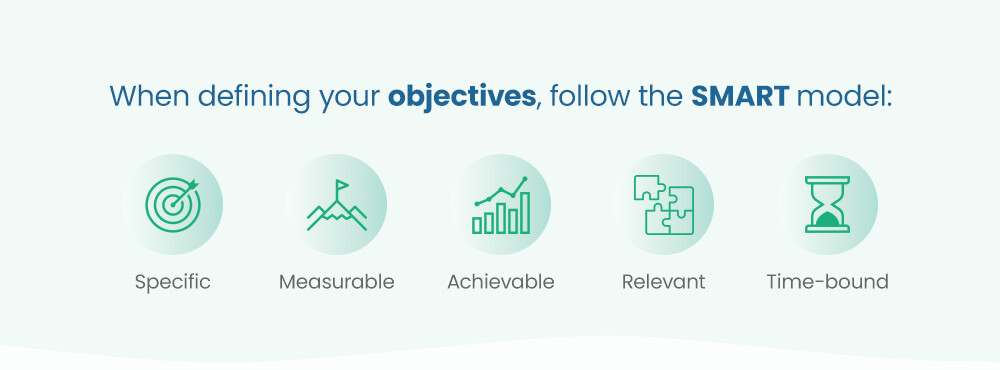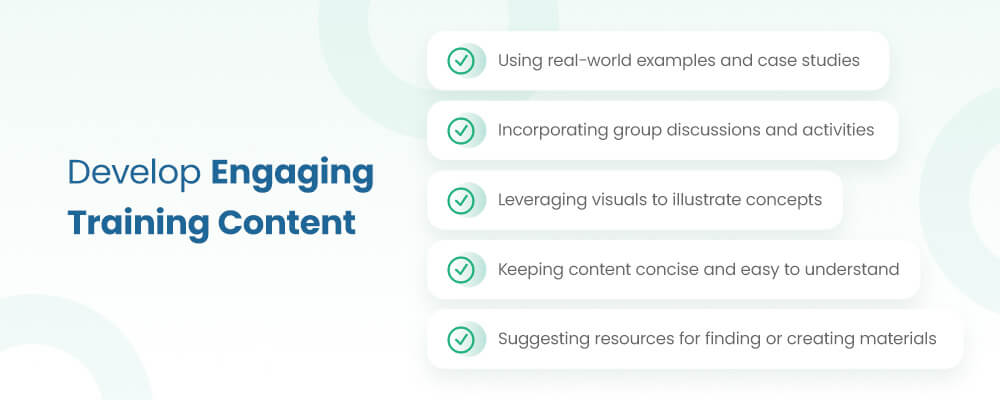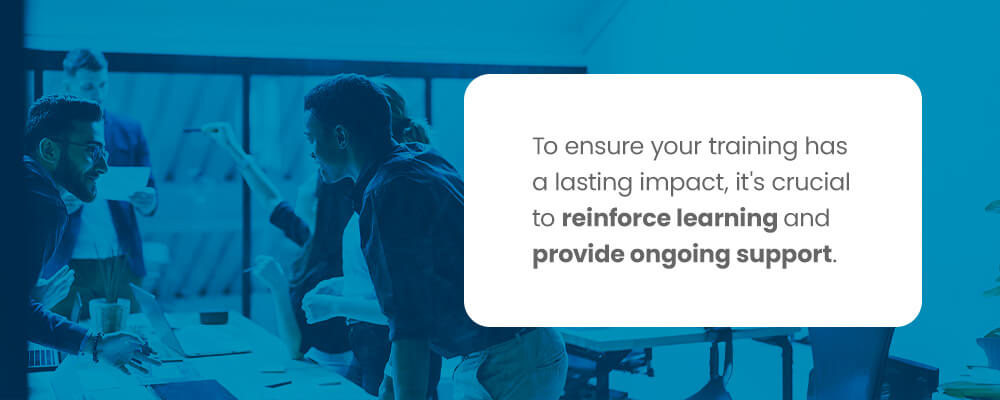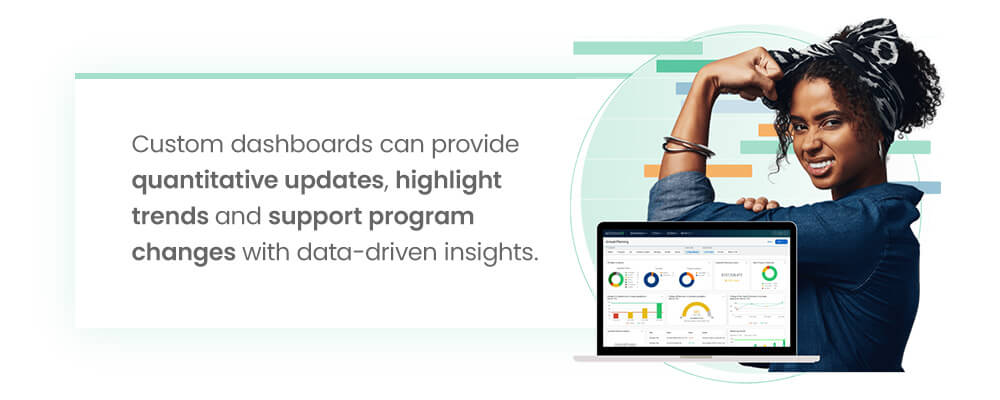Strategic planning is critical in enterprise organizations. This process involves understanding an organization’s goals, the steps necessary to achieve them and the impacts of goal success. Despite the importance of strategic planning, many organizations face several challenges in implementing a successful strategy. Teams resistant to change, a lack of resources, and insufficient data collection and monitoring can hinder strategic planning initiatives.
This guide will help strategy leaders navigate the strategic planning process and highlight solutions to these roadblocks.
In This Article
- Step 1. Assess Your Team’s Current Knowledge
- Step 2. Define Clear Learning Objectives
- Step 3. Choose the Right Strategic Training Plans
- Step 4. Develop Engaging Training Content
- Step 5. Deliver the Strategic Planning Training
- Step 6. Reinforce Learning and Provide Ongoing Support
- Step 7. Measure Training Effectiveness
Step 1. Assess Your Team’s Current Knowledge
Understanding your team’s baseline is crucial before implementing any training strategy and plan. This baseline allows you to tailor training to your team’s needs and identify precise knowledge gaps. You can allocate resources efficiently and invest in the most impactful activities and training materials. Additionally, you can ensure training is engaging and rich with new, relevant information rather than reinforcing information your team already knows.
You can also use your knowledge assessments to track progress as training occurs. Refer to the baseline measurements to understand training effectiveness and strengthen future processes.
Consider assessment techniques like:
Surveys and Questionnaires
Structured questionnaires and surveys can provide a holistic picture of each team member’s level of understanding, confidence and experience. This assessment method can help you identify patterns or trends you may not have considered. Keep in mind that this method relies on self-reporting, which means some team members may not relay their full depth of knowledge.
Surveys can feature questions like “How can we improve our strategic planning process?” and include rating scales to quantify confidence levels or process effectiveness.
Quizzes
Formal assessments like quizzes can highlight a team’s understanding of specific procedures and concepts. You can create quizzes with true-and-false questions, multiple-choice answers, short responses or a combination of each. These assessments are easy to score, giving you a straightforward baseline.
It may also help to combine assessment strategies. Example questions could include “Which of the following is the first step of strategic planning?” followed by multiple-choice answers or open-response prompts like “Describe the purpose of a strategic plan.”
Informal Discussions
Interviews and informal discussions are a great opportunity to encourage your team to discuss their understanding of best practices, processes and concepts in real time. This method allows you to explore knowledge and skills in-depth and could prompt hidden assumptions or misconceptions to arise, which you can address in training. This method can be time-consuming, especially for large organizations, so creating skilled interview teams can streamline the process but requires additional resources.
These discussions should include knowledge-based and experience-based questions. You can also include hypotheticals to understand how your team applies knowledge to realistic scenarios.
Tracking and Visualization
For assistance in tracking and visualizing team member understanding, consider a plan execution platform like AchieveIt. AchieveIt can integrate with assessment tools, including custom-built modules, to promote automatic administration and result collection. You can also manually enter data to create a comprehensive location for accessing your historical and current information.
AchieveIt also provides customizable dashboards, which you can leverage to display key metrics related to team understanding. Your dashboards can show average quiz scores, highlight score distributions across teams and empower you to find trends over time.
You can also link assessment data to your key performance indicators (KPIs) to determine how team understanding impacts organizational goals and outcomes. For example, you could track whether new sales strategy training prompts increased sales.
Step 2. Define Clear Learning Objectives

After collecting a team baseline, you can begin defining learning objectives. These objectives will guide your training strategy plan and enable you to create targeted, engaging and meaningful content. When defining your objectives, follow the SMART model:
- Specific: Your objective should be clear and state exactly what each team member should be able to do after completing training. For example, a communication-centered goal could be “Team members will be able to deliver a presentation on strategic initiatives using concise language and visual aids.”
- Measurable: Your objective must be quantifiable so you can determine when you’ve achieved it and monitor progress along the way. For example, rather than having a goal to “understand the principle of financial analysis,” a measurable goal could be “Team members will correctly calculate profit margins from the organization’s financial statements with 90% accuracy”.
- Achievable: Evaluate your time and resources available to ensure your objectives are realistic and attainable. Rather than hoping each team member becomes an expert in strategic planning, your goal could be to have each participant develop a basic understanding of key elements, such as mission statements and analyses for strengths and weaknesses.
- Relevant: Each objective should align with each learner’s needs and overall training goals. For example, it likely isn’t relevant for team members to understand the history of strategic planning, but a goal centered around applying principles to scenarios would be relevant.
- Time-bound: It is also important to set specific time frames or deadlines for objective completion. Time-bound objectives can help keep participants engaged and allow you to track progress and resource allocation. An example objective could include having team members create a project plan within one week of completing strategic planning training.
AchieveIt can help align individual and team objectives with overall strategic goals. The platform empowers you to access real-time progress reports, streamline collaboration and integrate plans to ensure alignment. Craft plans to suit your teams, automate progress updates, and leverage visualizations and custom dashboards to understand how plans impact your organization.
Step 3. Choose the Right Strategic Training Plans
Strategic planning training materials come in unique shapes and sizes. A well-designed strategy will engage your team members and support goal achievement. Depending on your specific goals and needs, you may find a combination of training plans suitable.
Training methods for your strategic planning team include:
- Workshops: Workshops and seminars are hands-on, interactive sessions that bring workers together. These methods allow participants to engage with real-world scenarios and practice active learning. Workers can also receive immediate feedback and collaborate with other workers. However, workshops can be time-consuming and resource-intensive. You also must have experienced facilitators to guide discussions and activities.
- Strategic planning training online: Online training strategies encourage workers to engage with self-paced learning modules. This method can be flexible, allowing employees to access training at any time. Online training can also be cost-effective for businesses compared to hosting live events on-site. However, this strategy requires employees to practice self-discipline and lacks collaboration opportunities.
- Mentoring: One-on-one guidance from experienced strategists can create personalized learning experiences for each team member. Mentors can offer practical guidance and real-world experience to help team members develop skills and understand concepts. Keep in mind that this method can be time-consuming, especially if you have many employees to train and few mentors to distribute. Additionally, mentors may unintentionally have biases that influence feedback and guidance.
- Simulations: Simulations enable team members to interact with realistic scenarios to practice strategic thinking. This method promotes experiential learning in a risk-free environment. Team members can see how their actions result in short-term and long-term impacts and collaborate with others for a rich learning experience. However, simulations can be a costly investment. It can also be challenging to assess learning progress when using this method alone.
Choosing the right training method requires understanding your needs and available resources. Consider pairing your training strategies with AchieveIt to monitor performance, access supplemental materials and guide meaningful training activities. AchieveIt offers training and support resources as an extension of software licensing, which means you can supplement your training methods with online modules, workshops, simulations and group discussions.
Step 4. Develop Engaging Training Content

Once you’ve determined the most impactful training methods for your teams, it’s time to craft engaging content. Engaging content can improve knowledge retention and enhance the learning experience. Your content should support your initiatives and leverage meaningful information and activities. You can create engaging content by:
- Using real-world examples and case studies: Case studies and real-world examples can show your team how the concepts they’re learning can apply to situations they may encounter on the job. Use personal business examples to connect your teams with your ideas and show data-driven insights. This content can give your training more credibility and deepen team understanding.
- Incorporating group discussions and activities: Group discussions and hands-on activities promote active participation among team members. This type of content can encourage critical thinking, collaboration and teamwork. Studies highlight that group discussions increase long-term retention and deepen topic understanding.
- Leveraging visuals to illustrate concepts: Multimedia like charts, graphs and diagrams can add visual interest to complex topics. Visuals are often more memorable than text and can help participants make stronger connections to the content.
- Keeping content concise and easy to understand: Avoid overwhelming your team by keeping information concise and easily digestible. Break content into manageable chunks by key concepts to make information more memorable. Also, consider how you present your information. Rather than hosting one session that is several hours long, you can use different training methods over the course of several days to keep team members engaged and motivated.
- Suggesting resources for finding or creating materials: Promote accountability by suggesting resources for additional learning. Supplemental resources encourage participants to dive into complex topics as deeply as they need to ensure understanding. This strategy can personalize the training experience, making it more memorable and engaging for each participant.
Step 5. Deliver the Strategic Planning Training
Now, it’s time to deliver your training materials. The following tips can help you maximize success during the rollout process:
- Create a comfortable and supportive learning environment: Comfortable and supportive learning environments minimize distractions and enhance focus. If you’re conducting on-site workshops or group activities, consider physical comfort elements like appropriate lighting and room temperatures, and psychological safety elements like positive reinforcement and strategies to include all team members in the process. Creating a supportive and comfortable environment can reduce anxiety or stress surrounding training and encourage better collaboration and creativity among participants.
- Encourage active participation and questions: State your expectations at the beginning of every training session. Highlight the importance of participation and utilize interactive activities to encourage collaboration. Ask for questions and feedback frequently, and provide thoughtful answers. Use technology to take polls or promote discussions with live chats.
- Use various teaching techniques: Everyone learns differently and has preferences surrounding training opportunities. Use various training techniques to engage as many team members as possible. A combination of group discussions, presentations, simulations and hands-on activities can strengthen team understanding and reduce content complexity.
Remember that some participants may be resistant to change. Prepare to answer difficult questions or interact with challenging participants. It can help to brainstorm some controversial questions before delivering your training. For example, experienced team members may ask about the purpose of training, question the validity of claims or voice concerns about underlying consequences. While it’s impossible to consider every resistive element you may encounter, thinking about these questions ahead of time can help you craft respectful answers and redirect conversations to stay on task.
For guidance during the training process, rely on AchieveIt’s support team to help. Our support capabilities include creating plans, editing item alignment, adding metrics and more. We can guide you through content organization, offer tips for delivery, and support progress tracking and monitoring to identify and overcome challenges.
Step 6. Reinforce Learning and Provide Ongoing Support

To ensure your training has a lasting impact, it’s crucial to reinforce learning and provide ongoing support. Without reinforcement, your team may forget critical information or miss opportunities to apply their knowledge. Ongoing support and learning reinforcement can also build confidence and highlight the importance of key concepts.
Here’s how you can reinforce learning after implementing the strategic training plan:
- Provide follow-up materials and resources: Resources and materials like case studies, training recordings and application tools are a great way to maintain momentum. Your team can review these materials to strengthen their understanding, reinforce complex concepts or practice applying their knowledge.
- Offer coaching and mentoring opportunities: Coaching or mentoring is an effective way to personalize learning reinforcement. Cultivating these one-on-one relationships can help workers feel more comfortable asking questions or requesting feedback. Mentors and coaches can also offer personal stories to exhibit the importance of training concepts to strengthen understanding.
- Encourage team members to apply their new knowledge in their daily work: Practice makes perfect, and the more opportunities your team has to apply their knowledge, the more confident they can become in their actions. Create a community of practice where team members can share their experiences and learn from each other.
AchieveIt provides ongoing access to strategic plans, progress updates and performance data, allowing you to reinforce learning and promote accountability within your team. AchieveIt can serve as your centralized resource library, enabling team members to revisit articles, presentations and checklists whenever they need them. You can also create quizzes and assessments and automate collection to track progress and determine whether you need to invest in additional training.
Step 7. Measure Training Effectiveness
Training never really ends. We all have more to learn, and measuring effectiveness is a great way to determine when it’s time to rethink your plan. It can help you identify training strengths and weaknesses and drive decision-making. Consider these methods of measuring effectiveness:
- Track relevant KPIs: KPIs are a powerful way to measure program effectiveness. Refer to the metrics you set when assessing team knowledge and compare results after delivering training. Your KPIs allow you to visualize the impact of training and determine areas where training did not achieve your desired impact.
- Conduct post-training surveys: A simple way to assess effectiveness is by asking your trainees. Assess knowledge retention and satisfaction by asking questions related to training and outcomes. Consider keeping these surveys anonymous so your team members feel more comfortable voicing their experiences.
- Observe team performance: Performance monitoring allows you to identify areas for improvement. You can monitor performance to determine whether team members are applying their skills and knowledge and the impact on your organization. A lack of skill usage on the job or poor results can indicate that you need to rework your training program.

You can use AchieveIt’s reporting and analytics features to track your KPIs and measure training program effectiveness with ease. Custom dashboards can provide quantitative updates, highlight trends and support program changes with data-driven insights.
Streamline Your Training Strategy and Empower Your Teams
Strategic planning is crucial for businesses. These strategies drive business decisions and support long-term growth and success. Training team members on strategic planning takes time, but the right tools can streamline the journey and align your process with your objectives. AchieveIt can help you throughout the entire training process, from plan development to ongoing support.
Ready to streamline strategic planning? Request a demo to see the solution in action.



